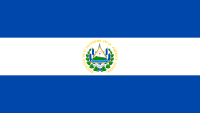Armed Forces of El Salvador
| Armed Forces of El Salvador Fuerza Armada de El Salvador |
|
|---|---|
 |
|
| Founded | 1842 |
| Service branches | Army, Air Force, Navy |
| Leadership | |
| Commander-in-Chief | Salvador Sánchez Cerén |
| Manpower | |
| Military age | 16 (voluntary) 18 (conscription) |
| Conscription | Yes |
| Available for military service |
1,634,816 males, age 16-49 , 1,775,474 (2008 est.) females, age 16-49 |
| Fit for military service |
1,201,290 males, age 16-49 , 1,547,278 (2009 est.) females, age 16-49 |
| Reaching military age annually |
77,473 males, 74,655 (2009 est.) females |
| Active personnel | 17,000 (2001 est.) |
| Expenditures | |
| Budget | $157,000,000 (2008 est.) |
| Percent of GDP | 0.62% |
| Industry | |
| Foreign suppliers |
|
| Related articles | |
| History | Football War, Salvadoran Civil War, War On Terror |
The Armed Forces of El Salvador, in Spanish Fuerza Armada de El Salvador is the official name of the combined armed forces of El Salvador.
It consists of three branches:
The Armed Forces of El Salvador have been in existence since the dissolution of the United Provinces of Central America in 1840.
Due to a growing tension between El Salvador and Honduras, which El Salvador accused of genocide, both countries went to war, this being sparked by a soccer game in what would later be known as the Football War. In July 14, 1969, the El Salvador Air Force attacked multiple airbases in Honduras. Because Honduras was caught by surprise, none of the Armed forces responded immediately. El Salvador had already sent ground forces to the border, and these forces invaded Honduras. The Honduran Army was pushed as much as 8 kilometers back into the country due to an intense artillery fire and armored intervention. Ocotepeque fell and the Salvadoran flag was raised in the city. This was the first time El Salvador had done this. By July 16, Honduran air fighters intercepted Salvadoran air fighters and proved to be better than Salvadoran fighters. Even thought Honduras bullied the Salvadoran Air Force, Honduras had to ask for a cease of fire because the Salvadoran ground forces were preparing to siege Tegucigalpa, the country's capital city. The war was over after 4 days of extremely intense fighting. El Salvador declared itself winner after having penetrated into Honduras and successfully reaching Tegucigalpa. The success of El Salvador was hidden under weeks of training and organizing forces. There were 4 ground theaters, air theater and a small navy unit in the Gulf of Fonseca. The North Theater was composed of ground forces, especially man-made forces with artillery and armored units. The Chalatenango Theater was only in case of a possible Honduran penetration into the country, this unit did not saw much fighting. The East Theater was made to penetrate Honduras with armored and artillery force. This unit saw much of the fighting leading to Tegucigalpa and used the highest amount of heavy ammunition, meaning tank, rocket and howitzer ammunition. The air theater was promising at the beginning for El Salvador, but was crushed by the Honduran Air Force. El Salvador Navy was on position only to support troops in the coast and to attack any passing-by airplane, it did not see much fighting.
During the Salvadoran Civil War the Armed Forces of El Salvador waged war against counter-insurgents organized under the FMLN. Following the end of the war, AFES personnel were implicated in many human rights abuses, including the November 1989 murder of Jesuit priests and others. In accordance with the peace agreements, the constitution was amended to prohibit the military from playing an internal security role except under extraordinary circumstances.
...
Wikipedia
